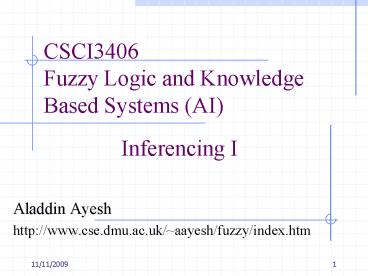CSCI3406 Fuzzy Logic and Knowledge Based Systems AI PowerPoint PPT Presentation
1 / 12
Title: CSCI3406 Fuzzy Logic and Knowledge Based Systems AI
1
CSCI3406 Fuzzy Logic and Knowledge Based Systems
(AI)
Inferencing I
- Aladdin Ayesh
- http//www.cse.dmu.ac.uk/aayesh/fuzzy/index.htm
2
Introduction
- Inferencing is often linked to reasoning.
- It is the process of deriving answers of
problems from knowledge that is maintained in a
KBS. - There are different types of Inferencing.
- In this lecture and next we cover some of the
most popular and commonly used types of
Inferencing.
3
Topics of Discussion
- Basic Components
- Backward chaining.
4
Basic Components
- The knowledge base
- The knowledge base contains the know-how of the
human experts in a particular field. Such
know-how is of two types- - Facts - "deep knowledge".
- Heuristics - "surface knowledge".
- Knowledge base is derived and implemented from
our knowledge analysis and representation. How
can a knowledge base be developed in CLIPS?
5
Basic Components
- The inference engine
- The inference engine, which has two primary
tasks - Inference the inference engine employs reasoning
to examine existing facts and rules. Updates
stored knowledge and draws conclusions. - Control the inference engine's mechanism for
controlling the search of the knowledge base.
6
Basic Components
- Working memory
- An area of the Computer's RAM reserved for
storing information regarding the current status
of the problem e.g. conclusions reached so far,
data input by the user and details of items
within the knowledge base which have been
checked. - How can you monitor the working memory in Fuzzy
CLIPS? How many parts are the working memory in
Fuzzy CLIPS?
7
Basic Components
- External data source
- Some expert systems receive input data from
external sources other than the user. Common
forms of this data - known as sensor data -
include X rays, audible sounds and visual images.
The system interprets the data and makes
inferences based on that data.
8
Backward chaining
- Backward chaining is a goal-driven approach.
- We start from an expectation of what is to
happen (hypothesis), then seek evidence that
supports (or contradicts) your expectation. - Often this entails formulating and
testing intermediate hypotheses (or
sub-hypotheses). - Backward chaining may use either depth first and
breadth first search algorithms. How?
9
Backward chaining
- Example
- IF
- Customer wants comfort and Customer has
enough_money - THEN
- Salesperson recommends Rolls Royce
- And assume you are the sales person, and your
question is do I recommend Rolls Royce to this
customer or not?
10
Conclusion
- In this lecture we looked at the second aspect of
knowledge based systems, namely, Inferencing. - There are different types of Inferencing one of
them is back chaining. - Search algorithms are often used in Inferencing.
11
References
- Lecture notes part 2.
- E. Turban, Expert Systems and Applied Artificial
Intelligence. New York Macmillan Publishing
Company, 1992.
12
Next Steps
- Next
- Forward chaining.
- Other types of Inferencing.

